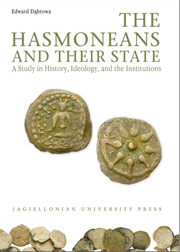Book contents
- Frontmatter
- Contents
- Introduction
- Abbreviations
- Part I Judea under the Hasmoneans (167–63 BCE)
- Part II The Institutions of the Hasmonean State
- I The Ruler
- 1 The Royal Priesthood or the Priestly Monarchy
- 2 The Priesthood
- 3 The Kingship
- 4 Succession
- 5 The Royal Family
- 6 The Court
- 7 The Capital City
- 8 The Palace and the Baris
- 9 Propaganda and Self-Presentation
- II The State
- Part III Society
- Conclusions
- Bibliography
- Index of Personal Names
- Index of Place Names
- Index of Ancient Sources
- Electrum - Volumes Published
- The Hasmonean State
4 - Succession
from I - The Ruler
Published online by Cambridge University Press: 05 September 2014
- Frontmatter
- Contents
- Introduction
- Abbreviations
- Part I Judea under the Hasmoneans (167–63 BCE)
- Part II The Institutions of the Hasmonean State
- I The Ruler
- 1 The Royal Priesthood or the Priestly Monarchy
- 2 The Priesthood
- 3 The Kingship
- 4 Succession
- 5 The Royal Family
- 6 The Court
- 7 The Capital City
- 8 The Palace and the Baris
- 9 Propaganda and Self-Presentation
- II The State
- Part III Society
- Conclusions
- Bibliography
- Index of Personal Names
- Index of Place Names
- Index of Ancient Sources
- Electrum - Volumes Published
- The Hasmonean State
Summary
Preservation and transfer of power within the ruling family is of fundamental importance to any monarchy. Clearly specified principles of royal succession are a condition on which depends the stability of this authority and the stability of the state in which it is exercised. Constitutional monarchies have the question of succession regulated by a number of legal clauses preventing any dynastic disputes from becoming an open conflict that would divide society into opposing camps. The case was very different in Hellenistic monarchies because the practically limitless power their kings enjoyed left only to them the decision to name the successor, a decision often taken amid pressures and intrigues. The striking testimony of the disastrous consequences of struggles for power within the ruling family are the dynastic contentions in the states of the Seleucids and the Ptolemies. In Hellenistic monarchies, the generally accepted and applied principle was for the reigning king to name his son as successor. A customary practice, it very often saw departures from it, which is why in effect the transit of power was not always smooth and free from conflict. The monarchy's person-centered nature meant that the king could just as well transfer authority according to his choosing, as if it was part of his personal property. Various rulers took decisions about succession, sometimes leading to dramatic events that affected the future of respective ruling houses. How portentous such decisions could be is confirmed by the history of the Hasmonean family.
- Type
- Chapter
- Information
- The Hasmoneans and their StateA Study in History, Ideology, and the Institutions, pp. 117 - 122Publisher: Jagiellonian University PressPrint publication year: 2009



